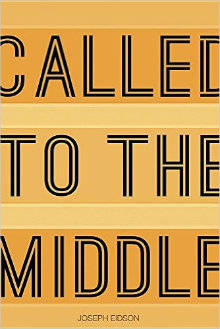Called to the Middle: A Principal’s View
Called to the Middle
By Joseph Eidson
(Joseph Eidson, 2016 – Learn more)
Reviewed by Linda Mancia

Still, I’ve always believed that having middle school students allowed me the best of all possible worlds – the innocent enthusiasm of the elementary child coupled with the growing boldness of an adolescent every day.

In my experience as a teacher, I have definitely found this to be true. It is in middle school, for example, when with an emphasis on critical reading, writing, and thinking, you can greatly impact a child’s intellectual development so key for future academic success.
Understanding the young adolescent
Called to the Middle is a primer for those who are trying to decide whether they are made for the challenges of this level of teaching. If they are, guidance is also offered on how to evaluate whether a middle school is effectively doing its most important job, which is to meet the needs of students and the classroom.
Called to the Middle clearly shows that its author has found his calling. Eidson’s descriptions of the characteristics of 6th, 7th, and 8th graders and how they amazingly grow before your eyes, brought a nostalgic tear to my eye. Being retired for only a few months, I was reminded of how wonderful it is to be in a middle school that provides “stability through solid structure, a nurturing environment, and high expectations.”
As Eidson points out, the best middle school teachers find joy in building relationships of trust with students despite their ever-present unpredictability. Effective middle school teachers also design procedures and lessons that give students the “structured freedom” they need to be engaged in active learning so their potential is maximized for success.
Eidson underscores how the best middle school classrooms challenge all students by seeking to meet a variety of learning styles and making failure not an option. He emphasizes how essential it is to maintain consistent communication not only between teacher and child but also between parent and teacher. To make parents a teacher’s ally, Eidson states, is the best way to provide “a full circle support system” for the students.
Core middle school systems
The second half of Called to the Middle emphasizes how important it is for a middle school to have at its core systems that support the students and teachers. According to Eidson, a middle school can only be really good if it considers what is in the best interest of its students. This is especially important when addressing issues of safety and the academic and personal lives of students.
“The environment defines the school,” says Eidson, and the leader of a middle school is the one chiefly responsible for setting the tone. As the principal of a middle school, he stresses that “the focus of everything in a building should support the classroom,” and that the leader should lead by example.
Eidson further emphasizes that a school must provide students the opportunities to make connections with others, especially with the adults in the building. Just as important is the time given to teachers to collaborate to meet students’ academic and emotional needs. All stakeholders of a school community, according to Eidson, are accountable for how well a middle school functions to benefit all its students.
Presentation challenges
Much of the advice Eidson offers to novice middle school teachers (and eventual school leaders) is sound. However, at times his conversational style affects the clarity of his well-intentioned message. This is especially true when personal anecdotes are used to illustrate a point, which often gets lost in the extraneous detail of the narrative. The characteristics that Eidson brands as “middle school” are many times ones necessary for all schools to be effective, not just those in the middle.
In addition, the author at times tends to bite off more than he can chew, especially when he introduces trends in education, such as professional learning communities (PLC’s) and data analysis. More than is necessary for the scope of this book is explained; yet too much opinion with too little substance is offered to provide an adequate explanation for those who are curious to learn more.
Unless you are a seasoned professional who recognizes what makes a middle school a great one, it is often tough to unearth without some struggle the gold nuggets that Eidson has buried inside Called to the Middle. Many times the reader is distracted by the unevenness of the writing and the redundancies in coverage. A tighter organization of the book’s content could have cut out repetition, most notably in the sections on teachers (“The Call,” “The Qualities,” “The Hero,” and “The Type”).
Chapters might have been better served to end with bulleted summary points rather than questions that sometimes do not cover the most salient points. It also might have been helpful to have supplemented the information given, which seems often to be overgeneralized since it is largely based on the author’s own professional school experiences.
Perhaps references to research-based studies on middle school and the inclusion of an annotated bibliography could have further enhanced the book’s credibility. Finally, more specific examples, especially in the area of best practices for middle school student engagement, would have increased the usefulness of the book to teachers new to the age group level.
Helpful to new middle school teachers
Joseph Eidson seems to be an effective middle school principal whose professional experiences reflect the passion and over-the-top enthusiasm that, as he rightfully claims, make those who teach this group so very special. Despite its limitations, Called to the Middle is a noble attempt to guide those starting out with much needed direction. I certainly would have benefited early on in my career to have known that it was best not to take the actions of my pre-adolescent charges so personally and to have had a lot more fun.
Linda Mancia is a retired educator from the Pelham Public Schools in Westchester County, New York, where for 24 years she taught Social Studies, reading and writing to middle and high school students, and worked in administration as a department supervisor and staff developer. She previously held a career as a developmental editor and then a freelance writer in educational publishing.




































“The characteristics that Eidson brands as “middle school” are many times ones necessary for all schools to be effective, not just those in the middle.” The author is limiting his readership if this is the case. Thanks for the thorough and honest review.
I didn’t even know that my principal wrote a book. Every day in classrooms I see this and every thing he states clearly outlines the way he runs our school.